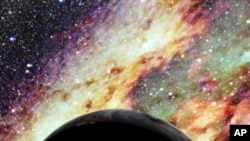Astronomers say lone, runaway worlds known as hypervelocity planets that cruise the cosmos at speeds of nearly 50 million kilometers per hour may be among the fastest objects in outer space.
The search for the existence of hypervelocity planets began after the discovery of hypervelocity stars seven years ago.
Scientists at the Harvard-Smithsonian Center for Astrophysics say their findings indicate that hypervelocity planets do exist, and they are produced the same way as hypervelocity stars - a too-close encounter with the gravity of a galaxy’s central supermassive black hole.
They say when a binary star system gets too close to the powerful gravitational forces of a supermassive black hole, one of the stars and one or more of the system's planets can be flung at high speed into space, while the other star remains trapped in orbit around the black hole.
While hypervelocity stars have been clocked moving at nearly 2.5 million kilometers per hour, even the slowest hypervelocity planet flies several times faster. The study's co-authors say most hypervelocity planets streak through interstellar space at 11 to 16 million kilometers per hour, but ideal conditions can produce much higher speeds - up to 48 million kilometers per hour, or a small percentage of the speed of light.
The Harvard-Smithsonian astronomers say they conducted their research with the help of a computer simulation because it is not possible to detect an individual hypervelocity planet. However, it is possible to detect one in orbit around a hypervelocity star, which the scientists say will dim slightly in brightness when a planet crosses between it and their telescope.
The new study will be published in the British journal Monthly Notices of the Royal Astronomical Society.
Astronomers use the term supermassive black hole to describe the large black hole believed to sit at the center of nearly all large galaxies, including our own galaxy, the Milky Way. Supermassive black holes are hundreds of millions, if not billions, of times the mass of the Sun.
News
Runaway Planets May Zoom Through Space at 30 Million KPH







